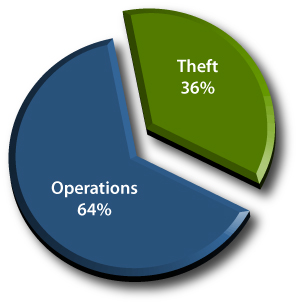Sources of Shrink Loss
Overall Shrink
 Research by FMI and The Retail Control Group into supermarket found overall shrink in 2011 at 2.70% of retail sales, with best in class companies (18%) reporting shrink at 1.72% of retail sales.
Research by FMI and The Retail Control Group into supermarket found overall shrink in 2011 at 2.70% of retail sales, with best in class companies (18%) reporting shrink at 1.72% of retail sales.
This figure confirms a six-year trend of retail shrink in supermarkets remaining principally unchanged. However, analysis of shrink prevention practices reveals two significant changes. Companies are measuring shrink loss better today and, as such, are reporting a more accurate (and higher) shrink number. Companies are also using technology and proven best practices more effectively, which helps reduce shrink.
For additional shrink resources, click here.
Definition of Shrink
Inventory shrink: The difference in the value of product received and the amount received for that product at the time of its sale.Inventory shrink is defined as the difference in the value of product received versus the amount received for that product at the time of its sale. This definition specifically covers inventory shrink loss, but does not include losses from cash shortages, bad checks, counterfeit money, coupon mishandling, and theft of time and time-card abuse, which are not classified as shrink in this survey.
When looking at the causes of inventory shrink it is important to note that some level of shrink is inherent in every retail operation. The key is to discover how much shrink is natural and therefore mostly uncontrollable vs. how much shrink is not natural and controllable.
Many factors contribute to store shrink; therefore, while a shrink problem may be relatively easy to define, it can remain difficult to solve. Reducing shrink first depends on determining its primary causes.
Causes of Shrink - Operations vs. Theft
 Store Operations. 64% of all store shrink occurs as a result of a breakdown in or the absence of operational best practices.
Store Operations. 64% of all store shrink occurs as a result of a breakdown in or the absence of operational best practices.
Operational shrink is profit loss caused during normal operations, usually due to a breakdown in controls and best practices. Participants indicated that significant store shrink results from the behaviors of store personnel and their failure to use store operations control best practices consistently.
With almost two-thirds of store shrink caused by operations, implementation and use of best practices and operations controls is the primary focus for companies targeting lower store shrink. 47% of companies report a growing shift in the role of loss/asset protection departments and a more collaborative partnership with store operations.
Theft. 36% of all reported shrink was attributed to theft and or misdeeds. Theft is that class of inventory and/or profit shrink caused by the stealing, pilfering, larceny, and other misdeeds resulting in product and profit loss. Theft is intentionally caused by one of three groups of people: Employees, customers, or vendors.
This lower percentage does not diminish the importance of combating shrink from theft, but it does allow retailers to prioritize and focus resources to areas with the greatest ROI.
Shrink by Type - Known vs. Unknown
Shrink loss can be classified into two categories: known and unknown shrink. By following consistent procedural recording and reporting practices, managers can properly account for known loss and then optimize their ability to control it. The unknown shrink that remains then becomes dependent on effective inventory and financial reconciliation.
Known Loss is shrink loss that can be identified, quantified and explained at the time the loss occurs. Known loss includes damage, distress, out of date or beyond sell by date, breakage, perishables not sold, customer returns, markdowns, blister packs from theft, etc. For example, if bottles fall off of a display or perishable product does not sell for full retail, that loss and its root causes can be identified and recorded as known loss.
Unknown Loss is shrink loss that cannot be specifically identified. For example, a shoplifter who steals a product without being detected creates unknown shrink. Most shoplifting, employee theft, and vendor theft create unknown shrink because there is no clear explanation or record as to how much loss actually occurred and/or why the physical inventory count does not match the store's book inventory. Therefore, if you are tracking both known and unknown loss, then unknown loss becomes the expected gross margin minus actual gross margin minus known loss. The realization that an unknown loss has occurred can be delayed by weeks, months, or longer, depending on how often the company takes physical inventory. The inventory reconciliation process can identify unknown shrink, but never its cause.
For additional questions regarding shrink research, operational best practices, or higher profit, email us at info@wheresmyshrink.com.

